

The Venus-Jupiter conjunction was this past Sunday (November 24, 2019). In late November, watch for the young moon to fly by Jupiter, Venus and Saturn in the west after sunset. Throughout December, Venus will be climbing upward, away from the sunset, while Jupiter is sinking downward. Jupiter will disappear in the sunset glare around mid-December.
Click the name of a planet to learn more about its visibility in November 2019: Venus, Jupiter, Saturn, Mars and Mercury.
Try Stellarium Online for a precise view from your location.
Venus – the brightest planet – reclaims her mantle as the evening “star” in December 2019. Last month, in November 2019, Venus assumed a low profile, lurking over the western horizon after sunset, beneath the planets Jupiter and Saturn. But Venus came into prominence in late November, when the queen planet finally met up with the king planet Jupiter for a stunning conjunction on November 24, 2019.
Next, Venus will catch up with Saturn for a conjunction on December 10, 2019. In the second half of December, Venus lords over Saturn and Jupiter in the evening sky. Jupiter and Saturn will soon fade away in the evening twilight, whereas dazzling Venus will grace the evening sky for several months to come.
At mid-northern latitudes in early December, Venus sets about two hours after sunset; but by the month’s end, that’ll increase to nearly three hours.
At temperate latitudes in the Southern Hemisphere, Venus sets about two hours after sunset throughout the month.
Watch for the young waxing crescent moon to pair up with Venus on or near December 28, as shown on the chart below.

Look for the young waxing crescent moon to couple up with Venus on or near December 28, 2019. Read more.
Jupiter – the second-brightest planet after Venus – can be found low in the west at dusk (beneath brighter Venus) during the first week or so of December 2019. Seek for Jupiter shortly after sunset because the king planet follows the sun the sun beneath the horizon before nightfall.
Jupiter should be visible to the eye alone during the first several days of December. Day by day, however, this world sinks closer the glow of sunset, and you’ll probably need binoculars to view Jupiter in the second week of December. By mid-month, Jupiter will probably disappear from view altogether.
Around the world, Jupiter sets around nightfall in early December. Then, by around December 7, Jupiter plunges beneath the horizon about one hour after the sun. Near the month’s end, Jupiter will transition out of the evening sky and into the morning sky. Jupiter will probably return to visibility in the east before sunrise in late January 2020.
EarthSky 2020 lunar calendars are available! They make great gifts. Order now. Going fast!

For North America, Venus and Saturn have their conjunction on the evening of December 10, 2019. Read more.
Saturn. After you find Venus at dusk and nightfall, use Venus, the sky’s brightest planet, to find the nearby fainter planet, Saturn. Although Saturn nowhere matches Venus in brilliance, Saturn does shine on par with the 1st-magnitude stars, or the sky’s brightest stars.
You really can’t mistake Saturn for Venus. The queen planet Venus ranks as the third-brightest celestial object in all the heavens, after the sun and moon. Venus outshines Saturn by more than 60 times.
Look for Saturn above Venus during the first part of December, and beneath Venus in the second half of the month. Throughout December, Venus climbs upward day by day, away from the sunset direction, while Saturn sinks downward and sunward. Look for these two worlds to meet up for a conjunction on or near December 10, as shown on the above sky chart.
By the month’s end, Saturn will sit low in the glow of evening twilight, and may be hard to see – even with binoculars. The first half of December presents the last good viewing of Saturn in the evening sky, before this world is submerged in the sun’s afterglow in late December.
Saturn will swing directly behind the sun on January 13, 2020, to transition out of the evening sky and into morning sky. After December passes, you might not see Saturn again until the ringed planet reappears in the eastern morning sky in February 2020.
Around the wold, Saturn plunges below the horizon about 3 hours after sunset in early December. Near the month’s end, Saturn sets about an hour after the sun.
If you’re up for a big challenge, try your luck at catching the young moon with Saturn after sunset on or near December 27, 2019, as shown on the sky chart below.

Look for the young waxing crescent moon to couple up with Saturn on or near December 27, 2019. Read more.
Mercury, the solar system’s innermost planet, recently reached its greatest elongation from the sun in the morning sky on November 28, 2019. Mercury remains a fine morning object as viewed from the Northern Hemisphere for the first week or two in December. Get up before dawn to see the 1st-magnitude star Spica lining up with the 2nd-magnitude planet Mars. Then, as the predawn darkness gives way to dawn, look for Mercury to climb above the horizon, more or less on line with Spica and Mars.
An imaginary line from Spica and past Mars, and down to the horizon, lets you know Mercury’s approximate rising point on the horizon, as shown on the sky chart below. Be mindful that Mars (and possibly Spica) will fade from view by the time that Mercury climbs above your horizon. Binoculars always come in handy for any Mercury quest.

Live in the Northern Hemisphere.? At northerly latitudes, the first week or so of December 2019 presents a fine opportunity for catching Mercury, the solar system’s innermost planet, in the predawn/dawn morning sky. Read more.
Where is Mars? From around the world, modestly-bright Mars now rises before dawn’s first light in the morning sky. At mid-northern latitudes, Mars rises about 2 1/2 hours before the sun in early December, and by the month’s end, rises some 3 hours before.
At temperate latitudes in the Southern Hemisphere, Mars comes up about 1 1/2 hours before the sun in early December, and about 2 1/2 hours before sunrise at the month’s end.
Let the old waning crescent moon help guide your eye to Mars for several mornings, centered on or near December 22, as shown on the sky chart below.

Are you a morning person? Around the time of the December solstice, watch for the moon to go by the celestial line-up: Spica, the brightest star in the constellation Virgo, Zubenelgenubi, the constellation Libra’s alpha star, and Mars, the 4th planet from the sun. Read more.
What do we mean by bright planet? By bright planet, we mean any solar system planet that is easily visible without an optical aid and that has been watched by our ancestors since time immemorial. In their outward order from the sun, the five bright planets are Mercury, Venus, Mars, Jupiter and Saturn. These planets actually do appear bright in our sky. They are typically as bright as – or brighter than – the brightest stars. Plus, these relatively nearby worlds tend to shine with a steadier light than the distant, twinkling stars. You can spot them, and come to know them as faithful friends, if you try.
Bottom line: In December 2019, a lineup of three planets – Saturn, Venus, and Jupiter – adorns the western sky at dusk/nightfall, with Saturn at top and Jupiter at bottom. Day by day, Venus climbs upward toward Saturn, until Venus and Saturn meet up for a conjunction on December 10. Mercury and Mars are morning planets, coming up before sun in the eastern sky. Click here for recommended almanacs; they can help you know when the planets rise and set in your sky.
Don’t miss anything. Subscribe to EarthSky News by email
Visit EarthSky’s Best Places to Stargaze, and recommend a place we can all enjoy.
Help EarthSky keep going! Donate now.
Post your planet photos at EarthSky Community Photos
from EarthSky https://ift.tt/1YD00CF


The Venus-Jupiter conjunction was this past Sunday (November 24, 2019). In late November, watch for the young moon to fly by Jupiter, Venus and Saturn in the west after sunset. Throughout December, Venus will be climbing upward, away from the sunset, while Jupiter is sinking downward. Jupiter will disappear in the sunset glare around mid-December.
Click the name of a planet to learn more about its visibility in November 2019: Venus, Jupiter, Saturn, Mars and Mercury.
Try Stellarium Online for a precise view from your location.
Venus – the brightest planet – reclaims her mantle as the evening “star” in December 2019. Last month, in November 2019, Venus assumed a low profile, lurking over the western horizon after sunset, beneath the planets Jupiter and Saturn. But Venus came into prominence in late November, when the queen planet finally met up with the king planet Jupiter for a stunning conjunction on November 24, 2019.
Next, Venus will catch up with Saturn for a conjunction on December 10, 2019. In the second half of December, Venus lords over Saturn and Jupiter in the evening sky. Jupiter and Saturn will soon fade away in the evening twilight, whereas dazzling Venus will grace the evening sky for several months to come.
At mid-northern latitudes in early December, Venus sets about two hours after sunset; but by the month’s end, that’ll increase to nearly three hours.
At temperate latitudes in the Southern Hemisphere, Venus sets about two hours after sunset throughout the month.
Watch for the young waxing crescent moon to pair up with Venus on or near December 28, as shown on the chart below.

Look for the young waxing crescent moon to couple up with Venus on or near December 28, 2019. Read more.
Jupiter – the second-brightest planet after Venus – can be found low in the west at dusk (beneath brighter Venus) during the first week or so of December 2019. Seek for Jupiter shortly after sunset because the king planet follows the sun the sun beneath the horizon before nightfall.
Jupiter should be visible to the eye alone during the first several days of December. Day by day, however, this world sinks closer the glow of sunset, and you’ll probably need binoculars to view Jupiter in the second week of December. By mid-month, Jupiter will probably disappear from view altogether.
Around the world, Jupiter sets around nightfall in early December. Then, by around December 7, Jupiter plunges beneath the horizon about one hour after the sun. Near the month’s end, Jupiter will transition out of the evening sky and into the morning sky. Jupiter will probably return to visibility in the east before sunrise in late January 2020.
EarthSky 2020 lunar calendars are available! They make great gifts. Order now. Going fast!

For North America, Venus and Saturn have their conjunction on the evening of December 10, 2019. Read more.
Saturn. After you find Venus at dusk and nightfall, use Venus, the sky’s brightest planet, to find the nearby fainter planet, Saturn. Although Saturn nowhere matches Venus in brilliance, Saturn does shine on par with the 1st-magnitude stars, or the sky’s brightest stars.
You really can’t mistake Saturn for Venus. The queen planet Venus ranks as the third-brightest celestial object in all the heavens, after the sun and moon. Venus outshines Saturn by more than 60 times.
Look for Saturn above Venus during the first part of December, and beneath Venus in the second half of the month. Throughout December, Venus climbs upward day by day, away from the sunset direction, while Saturn sinks downward and sunward. Look for these two worlds to meet up for a conjunction on or near December 10, as shown on the above sky chart.
By the month’s end, Saturn will sit low in the glow of evening twilight, and may be hard to see – even with binoculars. The first half of December presents the last good viewing of Saturn in the evening sky, before this world is submerged in the sun’s afterglow in late December.
Saturn will swing directly behind the sun on January 13, 2020, to transition out of the evening sky and into morning sky. After December passes, you might not see Saturn again until the ringed planet reappears in the eastern morning sky in February 2020.
Around the wold, Saturn plunges below the horizon about 3 hours after sunset in early December. Near the month’s end, Saturn sets about an hour after the sun.
If you’re up for a big challenge, try your luck at catching the young moon with Saturn after sunset on or near December 27, 2019, as shown on the sky chart below.

Look for the young waxing crescent moon to couple up with Saturn on or near December 27, 2019. Read more.
Mercury, the solar system’s innermost planet, recently reached its greatest elongation from the sun in the morning sky on November 28, 2019. Mercury remains a fine morning object as viewed from the Northern Hemisphere for the first week or two in December. Get up before dawn to see the 1st-magnitude star Spica lining up with the 2nd-magnitude planet Mars. Then, as the predawn darkness gives way to dawn, look for Mercury to climb above the horizon, more or less on line with Spica and Mars.
An imaginary line from Spica and past Mars, and down to the horizon, lets you know Mercury’s approximate rising point on the horizon, as shown on the sky chart below. Be mindful that Mars (and possibly Spica) will fade from view by the time that Mercury climbs above your horizon. Binoculars always come in handy for any Mercury quest.

Live in the Northern Hemisphere.? At northerly latitudes, the first week or so of December 2019 presents a fine opportunity for catching Mercury, the solar system’s innermost planet, in the predawn/dawn morning sky. Read more.
Where is Mars? From around the world, modestly-bright Mars now rises before dawn’s first light in the morning sky. At mid-northern latitudes, Mars rises about 2 1/2 hours before the sun in early December, and by the month’s end, rises some 3 hours before.
At temperate latitudes in the Southern Hemisphere, Mars comes up about 1 1/2 hours before the sun in early December, and about 2 1/2 hours before sunrise at the month’s end.
Let the old waning crescent moon help guide your eye to Mars for several mornings, centered on or near December 22, as shown on the sky chart below.

Are you a morning person? Around the time of the December solstice, watch for the moon to go by the celestial line-up: Spica, the brightest star in the constellation Virgo, Zubenelgenubi, the constellation Libra’s alpha star, and Mars, the 4th planet from the sun. Read more.
What do we mean by bright planet? By bright planet, we mean any solar system planet that is easily visible without an optical aid and that has been watched by our ancestors since time immemorial. In their outward order from the sun, the five bright planets are Mercury, Venus, Mars, Jupiter and Saturn. These planets actually do appear bright in our sky. They are typically as bright as – or brighter than – the brightest stars. Plus, these relatively nearby worlds tend to shine with a steadier light than the distant, twinkling stars. You can spot them, and come to know them as faithful friends, if you try.
Bottom line: In December 2019, a lineup of three planets – Saturn, Venus, and Jupiter – adorns the western sky at dusk/nightfall, with Saturn at top and Jupiter at bottom. Day by day, Venus climbs upward toward Saturn, until Venus and Saturn meet up for a conjunction on December 10. Mercury and Mars are morning planets, coming up before sun in the eastern sky. Click here for recommended almanacs; they can help you know when the planets rise and set in your sky.
Don’t miss anything. Subscribe to EarthSky News by email
Visit EarthSky’s Best Places to Stargaze, and recommend a place we can all enjoy.
Help EarthSky keep going! Donate now.
Post your planet photos at EarthSky Community Photos
from EarthSky https://ift.tt/1YD00CF


Aucun commentaire:
Enregistrer un commentaire